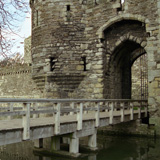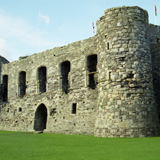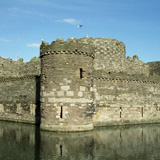History
In April of 1295, Edward I of England began construction of Beaumaris Castle in Northern Wales on the island of Anglesey near the coast of Conwy Bay. To build the last of his iron ring of castles, he appointed Master James of St. George, who assisted with many other Edwardian castles in North Wales, to oversee the effort.

Although building activities spanned nearly four decades, Beaumaris Castle was never completed, as most funding was required to support Edward's wars with Scotland. When building ceased in the 1330s, the great towers of the inner ward still needed their top floors, and some turrets were never started. Consequently, the castle is visually less impressive than Harlech and Conwy since it does not dominate the surrounding countryside. Despite never completing construction, Beaumaris Castle contains some history.
The Welsh besieged the castle in 1403 during a revolt led by Owain Glyndwr against English rule. However, it was retaken by the English only a couple of years later, in 1405.
In March of 1592, the Welsh Catholic priest and martyr William Davies was imprisoned in the castle's dungeon and eventually hanged, drawn, and quartered at Beaumaris Castle on July 27th, 1593. This was his penalty for being a Catholic priest in a Protestant country.
Beaumaris Castle was a strategic location during the English Civil War since it controlled part of the route between Ireland and the king's headquarters in England. The castle was managed on behalf of the king by the Bulkeley family. In 1646, Parliamentarians defeated royalist armies, and Colonel Richard Bulkeley surrendered the castle. Royalists revolted against Parliamentarians once again in 1648 but eventually surrendered a second time in October of that year. Beaumaris Castle was not slighted or damaged, as was the fate of many castles captured by Parliamentarians under Oliver Cromwell. Architectural defenses were crucial for survival due to the need for protection against potential royalist invasions from Scotland.
When Charles II returned to the throne in 1660, he restored the Bulkeley family as constables for Beaumaris Castle. By this time, the castle had already been stripped of its valuable resources, including lead-based roofs. Thereafter, Beaumaris Castle fell into a state of neglect, eventually becoming dilapidated and overgrown with ivy. In 1925, Richard Williams-Bulkeley gave the castle to the Commission of Works, which performed restoration work, including removing vegetation, repairing stonework, and excavating the moat. Today, Beaumaris Castle is managed by Cadw, the Welsh Assembly Government's agency for historical monuments.
Castle Highlights
Beaumaris Castle remains in a partially built state, much the same as during the 1330s, thus providing great insight into the castle building process and considered by historians as "the most perfect example of symmetrical concentric castle planning." Similarly, its architecture was praised by the United Nations Educational, Scientific and Cultural Organization (UNESCO) as one of the finest examples of late 13th century and early 14th century military architecture in Europe.
The design of Beaumaris Castle represents a concentric architecture comparable to both Rhuddlan and Harlech. Concentric castles rely on two concentric rings of walls and towers to provide added security and multiple layers of defense. This includes an inner courtyard surrounded by a high curtain wall enclosed by a shorter wall, and both encircled by a moat. The inner ward consists of two massive gatehouses on the castle's northern and southern portions, representing the most significant parts of the structure. Aside from the gatehouses, the inner ward contains six towers. The castle was constructed from Anglesey stone, a mixture of limestone, sandstone, and schists.
In addition, the Chapel Tower includes an exhibit entitled The Castles of King Edward I. Beaumaris Castle, though not a towering nor foreboding castle due to the incomplete height of its towers, still represents an impressive and picturesque site with its dark stone and water-filled moat surrounding the outside of most of the castle. Moreover, there is no central keep as found with Norman motte and bailey style castles.
Beaumaris Castle can be explored in about two to four hours, leaving ample time to visit nearby Conwy Castle to the east or Caernarfon Castle to the west.
Bauemaris Castle is also haunted.



